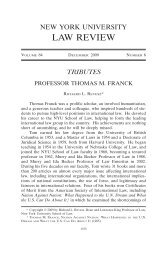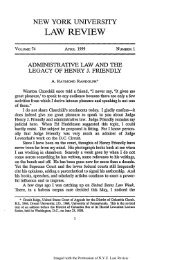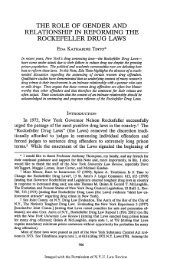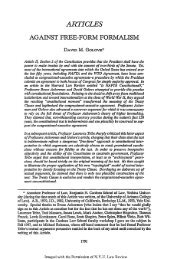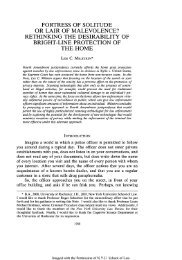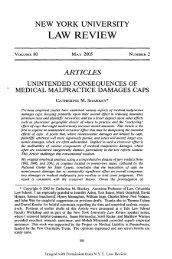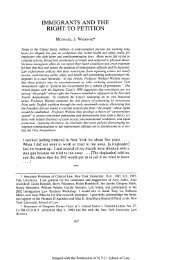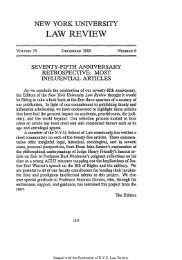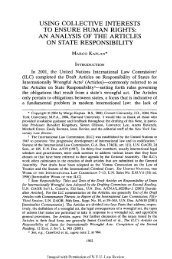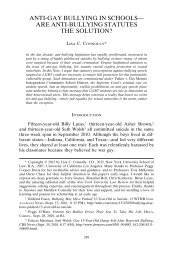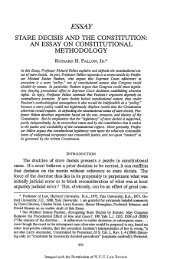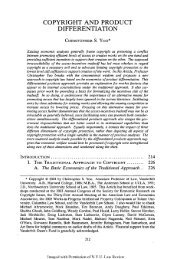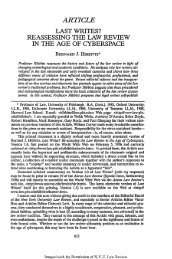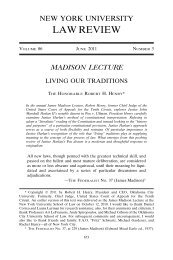Two and Twenty (NYU Law Review 2008). - Victor Fleischer
Two and Twenty (NYU Law Review 2008). - Victor Fleischer
Two and Twenty (NYU Law Review 2008). - Victor Fleischer
You also want an ePaper? Increase the reach of your titles
YUMPU automatically turns print PDFs into web optimized ePapers that Google loves.
\\server05\productn\N\<strong>NYU</strong>\83-1\<strong>NYU</strong>101.txt unknown Seq: 34 19-MAR-08 7:3534 NEW YORK UNIVERSITY LAW REVIEW [Vol. 83:1get into <strong>and</strong> get out of a partnership without incurring tax. But it isnot as simple as a sole proprietorship. 147But this policy goal of facilitating pooling lacks a solid normativejustification. Pooling of labor <strong>and</strong> capital takes place in all entityforms, from a sole proprietorship to a publicly traded corporation <strong>and</strong>everything in between, like mutual funds, real estate investmenttrusts, <strong>and</strong> insurance companies. It is not self-evident why we shouldadvantage partnerships over other entity classifications. If we acceptas a given that we treat sole proprietors one way <strong>and</strong> corporate executivesanother, the determination of how to treat partners turns, amongother things, on whether the activities conducted by partners moreclosely resemble the activities of sole proprietors on the one h<strong>and</strong> orcorporate executives on the other. Taxing similar activities alikereduces deadweight loss by discouraging restructuring out of theoptimal business form in order to reduce taxes. 148The normative underpinnings of treating partners more like soleproprietors than executives have gone largely unexamined. ProfessorLaura Cunningham, for example, has argued that a partnership profitsinterest granted in exchange for future services should not be treatedas a realization event, notwithst<strong>and</strong>ing the arbitrary distinctionbetween a capital interest <strong>and</strong> a profits interest. 149 While resting her147 With a sole proprietorship, the owner can immediately invest her own money (orborrowed money) into the business <strong>and</strong> enjoy any tax benefits, such as depreciation of thebusiness’s assets, that may follow.148 It is worth emphasizing that arbitrary line-drawing between pooling transactions(treated as nonrecognition events) <strong>and</strong> exchange transactions (treated as recognitionevents) already takes place under current law. The current rules treat the receipt of aprofits interest as a pooling event, since this is not recognized as a taxable event, but theytreat receipt of a capital interest as an exchange subject to immediate taxation (like thereceipt of other forms of property, like stock or cash, received in exchange for services).See supra notes 33–46 <strong>and</strong> accompanying text (describing tax treatment of profits interest<strong>and</strong> capital interest received in exchange for services). Professor Laura Cunningham’s1991 Tax <strong>Law</strong> <strong>Review</strong> article challenged the logic of distinguishing between a capitalinterest <strong>and</strong> a profits interest in a partnership: “[T]here is no economic distinctionbetween capital <strong>and</strong> profits interests which would justify taxing them differently.”Cunningham, supra note 42, at 248. Because the value of a profits interest, like the valueof a capital interest, depends on the value <strong>and</strong> expected return of the partnership’s underlyingassets, she concluded that the distinction is without a difference. Id. at 256. Treatinga profits interest as speculative simply because it has no current liquidation value, see supranote 33 (discussing liquidation value), does not bring one closer to economic reality.149 For Professor Cunningham, the only relevant question is whether the partnershipinterest is received for services performed in the past or expected to be performed in thefuture. Property received for services already performed ought to be taxed currently,according to Professor Cunningham, regardless of whether the property is styled as aprofits interest or a capital interest. Cunningham, supra note 42, at 260. If property isreceived in exchange for future services, however, current taxation would violate realizationprinciples, see id. (“[W]here all or substantially all of the services . . . are completed atthe time [the recipient partner] receives his interest in the partnership, . . . the realization



